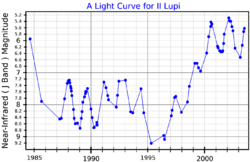Astronomy:II Lupi
| Observation data Equinox J2000.0]] (ICRS) | |
|---|---|
| Constellation | Lupus |
| Right ascension | 15h 23m 05.073s[2] |
| Declination | −51° 25′ 58.76″[2] |
| Characteristics | |
| Spectral type | C[3] |
| Apparent magnitude (I) | 10.18[4] |
| Apparent magnitude (J) | 5.92[5] |
| Apparent magnitude (K) | 1.79[5] |
| Variable type | Mira[6] |
| Astrometry | |
| Proper motion (μ) | RA: −12.992[2] mas/yr Dec.: −13.119[2] mas/yr |
| Parallax (π) | 1.5633 ± 0.2138[2] mas |
| Distance | approx. 2,100 ly (approx. 640 pc) |
| Absolute magnitude (MV) | −5.15[7] |
| Details | |
| Mass | 2.2[2] M☉ |
| Radius | 547[3] R☉ |
| Luminosity | 8,900[8] L☉ |
| Surface gravity (log g) | 0.06[2] cgs |
| Temperature | 2,800[8] K |
| Age | 942[2] Myr |
| Other designations | |
| Database references | |
| SIMBAD | data |
II Lupi (IRAS 15194-5115) is a Mira variable and carbon star located in the constellation Lupus. It is the brightest carbon star in the southern hemisphere at 12 μm.
In 1987, the infrared source IRAS 15194-5115 was identified as an extreme carbon star. It was seen to be strongly variable at optical and infrared wavelengths. It is very faint visually, 15th or 16th magnitude in a red filter and below 21st magnitude in a blue filter, but at mid-infrared wavelengths (N band) it is the third-brightest carbon star in the sky.[9] A star at the location had earlier been catalogued as WOS 48, a possible S-type star, on the basis of strong LaO bands in its spectrum.[10]
On the basis of infrared photometry,[11] IRAS 15194-5115 was given the variable star designation II Lupi in 1995, although the variability type was still unknown.[12] More detailed infrared photometry confirmed that II Lupi was a Mira variable and showed regular variations with a period of 575 days over 18 years. The mean magnitude also dimmed and brightened during that time and has been characterised as a 6,900-day secondary period although less than a full cycle was observed. The secondary period could be interpreted as an isolated or irregular obscuration event in a dust shell surrounding the star.[13]
II Lupi has a strong stellar wind averaging 10−5 solar masses per year.[14]
References
- ↑ Lykou, Foteini; Zijlstra, A. A.; Kluska, J.; Lagadec, E.; Tuthill, P. G.; Avison, A.; Norris, B. R. M.; Parker, Q. A. (October 2018). "The curious case of II Lup: a complex morphology revealed with SAM/NACO and ALMA". Monthly Notices of the Royal Astronomical Society 480 (1): 1006–1021. doi:10.1093/mnras/sty1903. Bibcode: 2018MNRAS.480.1006L.
- ↑ 2.0 2.1 2.2 2.3 2.4 2.5 2.6 2.7 Vallenari, A. et al. (2022). "Gaia Data Release 3. Summary of the content and survey properties". Astronomy & Astrophysics. doi:10.1051/0004-6361/202243940 Gaia DR3 record for this source at VizieR.
- ↑ 3.0 3.1 De Beck, E.; Decin, L.; De Koter, A.; Justtanont, K.; Verhoelst, T.; Kemper, F.; Menten, K. M. (2010). "Probing the mass-loss history of AGB and red supergiant stars from CO rotational line profiles. II. CO line survey of evolved stars: Derivation of mass-loss rate formulae". Astronomy and Astrophysics 523: A18. doi:10.1051/0004-6361/200913771. Bibcode: 2010A&A...523A..18D.
- ↑ DENIS Consortium (2003). "VizieR Online Data Catalog: The DENIS database (DENIS Consortium, 2003)". VizieR On-line Data Catalog. Bibcode: 2003yCat....102002T.
- ↑ 5.0 5.1 Whitelock, Patricia A; Feast, Michael W; Marang, Freddy; Groenewegen, M. A. T (2006). "Near-infrared photometry of carbon stars". Monthly Notices of the Royal Astronomical Society 369 (2): 751–782. doi:10.1111/j.1365-2966.2006.10322.x. Bibcode: 2006MNRAS.369..751W.
- ↑ Samus, N. N. et al. (2009). "VizieR Online Data Catalog: General Catalogue of Variable Stars (Samus+ 2007-2013)". VizieR On-line Data Catalog: B/GCVS. Originally Published in: 2009yCat....102025S 1. Bibcode: 2009yCat....102025S.
- ↑ Guandalini, R; Cristallo, S (2013). "Luminosities of carbon-rich asymptotic giant branch stars in the Milky Way". Astronomy & Astrophysics 555: A120. doi:10.1051/0004-6361/201321225. Bibcode: 2013A&A...555A.120G.
- ↑ 8.0 8.1 Ramstedt, S.; Olofsson, H. (2014). "The 12CO/13CO ratio in AGB stars of different chemical type. Connection to the 12C/13C ratio and the evolution along the AGB". Astronomy & Astrophysics 566: A145. doi:10.1051/0004-6361/201423721. Bibcode: 2014A&A...566A.145R.
- ↑ Meadows, P. J; Good, A. R; Wolstencroft, R. D (1987). "The identification of IRAS 15194-5115 with a bright extreme carbon star". Monthly Notices of the Royal Astronomical Society 225: 43p–49p. doi:10.1093/mnras/225.1.43P. Bibcode: 1987MNRAS.225P..43M.
- ↑ Westerlund, B. E; Olander, N (1978). "S stars in the southern Milky Way". Astronomy and Astrophysics Supplement Series 32: 401. Bibcode: 1978A&AS...32..401W.
- ↑ Le Bertre, T (1992). "Carbon-star lightcurves in the 1-20 micron range". Astronomy and Astrophysics Supplement Series 94: 377. Bibcode: 1992A&AS...94..377L.
- ↑ Kazarovets, E. V; Samus, N. N (1995). "The 72nd Name-List of Variable Stars". Information Bulletin on Variable Stars 4140: 1. Bibcode: 1995IBVS.4140....1K.
- ↑ Feast, Michael W; Whitelock, Patricia A; Marang, Freddy (2003). "The case for asymmetric dust around a C-rich asymptotic giant branch star". Monthly Notices of the Royal Astronomical Society 346 (3): 878. doi:10.1111/j.1365-2966.2003.07136.x. Bibcode: 2003MNRAS.346..878F.
- ↑ Smith, C. L.; Zijlstra, A. A.; Fuller, G. A. (2015). "A molecular line survey of a sample of AGB stars and planetary nebulae". Monthly Notices of the Royal Astronomical Society 454 (1): 177–200. doi:10.1093/mnras/stv1934. Bibcode: 2015MNRAS.454..177S.
 |


